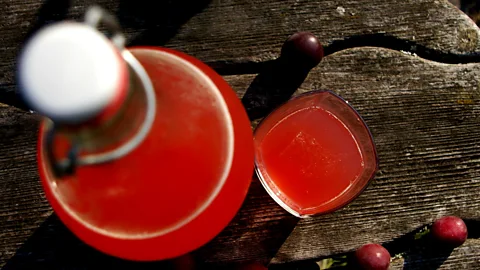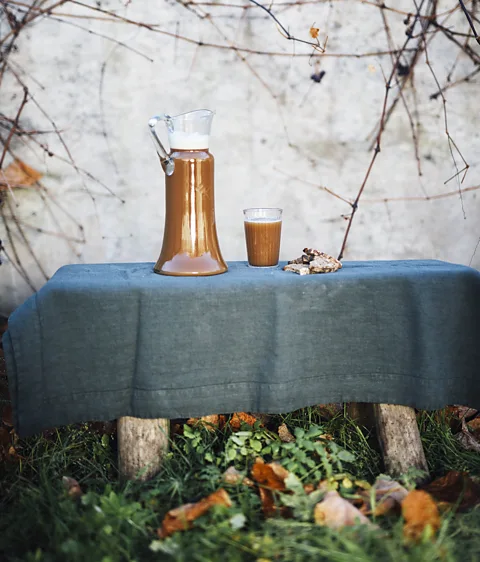Josas agrees. "Many believed kvass was good for digestion and immunity, thanks to its probiotics. My great-grandparents made traditional homebrewed gira, very different from today's commercial versions [that are sweeter]. It had a funky, tangy flavor from lactobacillus – like sauerkraut has, but in liquid form. I wasn't a fan as a child since it lacked sugar, but once I got into beer, I learned to love its complexity," he says.
 Ieva Šidlaitė
Ieva ŠidlaitėThe early '80s is what Josas describes as "the golden age of gira" with mobile barrels selling it on every street corner during summer. However as global soft drinks like Coke flooded the Baltic market, gira struggled to compete, losing its appeal and audience. To survive, manufacturers began mass-producing the drink using sugar for appeal and cheap malt extract to speed up the process, shifting it closer to soda than traditional fermentation.
"Kvass lacks a strong identity, a clear drinking culture or an image that appeals to younger generations," says Josas, noting that while gira shares the same probiotic qualities of kombucha, it has never been "hyped" as a health drink. But things are changing, he says. Artisanal gira brands are reviving traditional methods, tapping into kombucha's success.
One of Lithuania's largest producers of beer and gira is Gubernija Brewery in northern Lithuania who, despite their large-scale production, still make their gira traditionally: with black grain bread. However, the 360-year-old brewery is also adapting for modern palates.
More like this:
• Japan's ancient fermented 'superdrink'
• The national park that draws mushroom hunters from around the world
"We have created different varieties of kvass to widen our audience in the last few years," says Jogailė Čojūtė, export specialist for Gubernija Brewery. "For example, our white wheat bread gira is aimed at younger consumers who like trendy soft drinks. The taste is much milder. Another popular item we have is the dark rye bread gira with hemp and hints of lime; it is a unique and refreshing twist to our traditional recipe and proves that gira really can stand the test of time."
"In 2024, we observed an 18% increase in the sales volume of owned gira brands compared to the previous year," she continues, "while export sales volume grew by 47%."
 Ieva Šidlaitė
Ieva ŠidlaitėGlobally, interest in non-alcoholic beverages and low-ABV drinks is soaring, and kvass is catching on. In the US, breweries, bakeries and even restaurants have released their own versions of kvass with great success. Dan Woods of Beaver Brewing Company in Pennsylvania produces kvass in his nanobrewery; while at Honey's in East Williamsburg in New York, kvass made an appearance on tap. Made with chunks of toasted dark sourdough rye bread which were left to ferment, the slightly tart drink was sweetened with a touch of honey and also served as a cocktail.
Where to try Gira
In Vilnius, traditional restaurants like Lokys have kvass on the menu; it pairs incredibly well with a plate of smoked cold cuts. Elsewhere around the city, small batch gira made traditionally with bread can be found in health food shops as well as popular city bakery Kmyninė, which uses its leftover sourdough rye.
In Australia, a string of bakeries have collaborated with local craft breweries to make stronger alcoholic versions, such as Three Mills Bakery in the nation’s capital, Canberra; while in Leeds in the UK, Northern Monk releases a seasonal kvass each year.
While some international versions exceed 4% ABV, for Lithuanians, it remains a drink with cultural significance that should only be fermented to 1.2% ABV at most. "It should not be considered a direct substitute for beer," says Čojūtė.
Instead, Eidukevičius says, the beauty of the unassuming drink lends itself to a nice refresher anytime of the day with its sweet, acidic, tangy and even funky taste.
"Gira, for all its refreshing qualities, can be a bit of a mischievous drink," Eidukevičius adds. "There's a running joke in Lithuanian households about 'gira explosions' because it ferments in closed containers where enormous pressure can build up like a bottle of Champagne. There's nothing quite like walking into a cellar and finding gira sprayed across the walls and ceiling like some kind of fizzy, rye-bread-scented geyser. It's a testament to how alive this drink is. It's a reminder that we're working with natural processes, and sometimes, those processes have a mind of their own."
So, if you find yourself in Lithuania looking for a low-alcohol beverage, consider a glass of gira. "Drinking gira is a connection to our land and to the traditions that have shaped Lithuania's culture," says Eidukevičius."It has a long tradition in my beautiful country as more than just a beverage; it's a part of our cultural heritage and a link to our ancestors' traditions."
--
